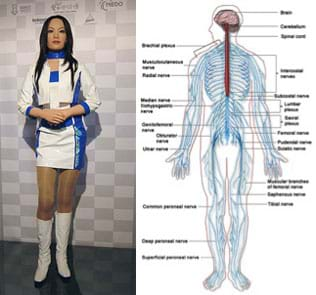
Summary
Students learn about the human body's system components, specifically its sensory systems, nervous system and brain, while comparing them to robot system components, such as sensors and computers. The unit's life sciences-to-engineering comparison is accomplished through three lessons and five activities. The important framework of "stimulus-sensor-coordinator-effector-response" is introduced to show how it improves our understanding the cause-effect relationships of both systems. This framework reinforces the theme of the human body as a system from the perspective of an engineer. This unit is the second of a series, intended to follow the Humans Are Like Robots unit.Engineering Connection
Comparing neuroscience and engineering shows us the functional similarities between the human brain and human-made computers, sensors and robots. Electrical, mechanical and biological engineers apply mathematical principles similar to those used in human brains and systems as they devise improved robots, computers and sensors. With the growing popularity of the biological engineering and systems neurobiology fields, engineers are becoming more involved in human body research involving efforts to replicate the functioning of many of human systems. For example, engineers are designing walking robots with artificial organs, such as heart and liver, and bio-sensors, such as for detecting sugar levels for diabetics.
Educational Standards
Each TeachEngineering lesson or activity is correlated to one or more K-12 science,
technology, engineering or math (STEM) educational standards.
All 100,000+ K-12 STEM standards covered in TeachEngineering are collected, maintained and packaged by the Achievement Standards Network (ASN),
a project of D2L (www.achievementstandards.org).
In the ASN, standards are hierarchically structured: first by source; e.g., by state; within source by type; e.g., science or mathematics;
within type by subtype, then by grade, etc.
Each TeachEngineering lesson or activity is correlated to one or more K-12 science, technology, engineering or math (STEM) educational standards.
All 100,000+ K-12 STEM standards covered in TeachEngineering are collected, maintained and packaged by the Achievement Standards Network (ASN), a project of D2L (www.achievementstandards.org).
In the ASN, standards are hierarchically structured: first by source; e.g., by state; within source by type; e.g., science or mathematics; within type by subtype, then by grade, etc.
See individual lessons and activities for standards alignment.
Subscribe
Get the inside scoop on all things TeachEngineering such as new site features, curriculum updates, video releases, and more by signing up for our newsletter!Unit Schedule
Conduct the lessons and activities in the following order:
- Lesson 1: Brain is a Computer --> Activity 1: That's Hot! Robot Brain Programming
- Lesson 2: Humans and Robot Sensors --> Activity 2: Commanding a Robot Using Sound --> Activity 3: Hearing: How Do Our Ears Work? --> Activity 4: Sound from Left or Right?
- Lesson 3: Reflecting on Human Reflexes --> Activity 5: Pupillary Response & Test Your Reaction Time

More Curriculum Like This

Through six lesson/activity sets, students learn about the functioning of sensors, both human and robotic. The overall framework reinforces the theme of the human body as a system with sensors—that is, from an engineering perspective.

Students gain a rigorous background in the primary human "sensors," as preparation for comparing them to some electronic equivalents in the associated activity. Students learn the concept of "stimulus-sensor-coordinator-effector-response" to describe the human and electronic sensory processes.

Students learn about the similarities between the human brain and its engineering counterpart, the computer. Since students work with computers routinely, this comparison strengthens their understanding of both how the brain works and how it parallels that of a computer.

Students learn about human reflexes, how our bodies react to stimuli and how some body reactions and movements are controlled automatically, without thinking consciously about the movement or responses. In the associated activity, students explore how reflexes work in the human body by observing an ...
Copyright
© 2013 by Regents of the University of Colorado; original © 2012 Curators of the University of MissouriContributors
Sachin Nair, Charlie Franklin, Marianne Catanho, Satish NairSupporting Program
GK-12 Program, Computational Neurobiology Center, College of Engineering, University of MissouriAcknowledgements
This curriculum was developed under National Science Foundation GK-12 grant number DGE 0440524. However, these contents do not necessarily represent the policies of the National Science Foundation, and you should not assume endorsement by the federal government.
Last modified: November 21, 2017







User Comments & Tips